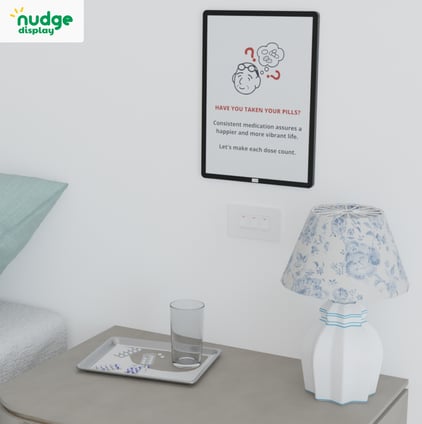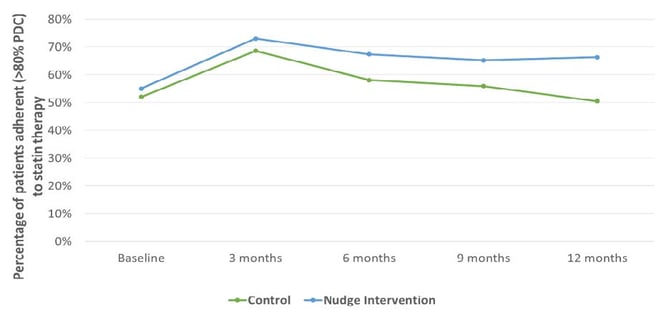Nudge Display in Care Homes
NUDGING IN PRACTICE
5/15/20243 min read


Imagine a residential space where technology seamlessly blends with care, gently nudging residents and staff towards a healthier and happier environment. This is not science fiction; it is the potential of Nudge Displays.
More than Static Signage
Nudge Displays go beyond traditional posters and whiteboards. This digital platform leverages the power of visuals, gamification, and Nudge Theory to encourage positive behaviours and improve overall well-being in care homes.
For example, In the delicate ecosystem of a care home, hygiene practices play a vital role in protecting both residents and staff. From handwashing routines to medication adherence, maintaining proper hygiene is paramount in preventing infections and ensuring the well-being of everyone. However, traditional approaches like posters and verbal reminders can sometimes fall short in capturing consistent attention and encouraging long-term positive behaviour change. Below are some ways the Nudge Display messaging platform can play a role:
Engaging Hygiene Education
Displays can showcase short, engaging animations demonstrating proper handwashing techniques, tailored to different needs. Residents with cognitive decline can benefit from visuals, while others may appreciate animations focusing on specific procedures like catheter care.
Challenges in the Form of Games
Transform handwashing and cleaning into a fun and social activity! Residents can participate in virtual challenges, competing with peers on leaderboards or earning points for completing steps correctly. Studies show gamification significantly increases motivation and engagement, particularly among older adults.
Medication Reminders Made Easy
Visual Medication Reminders
Personalised schedules displayed on Nudge Displays can remind residents about medications, including pictures and clear instructions. These reminders can encourage adherence, especially for medication requiring handwashing before or after administration.
To-Do Lists
Caregivers can create to-do lists for residents with specific needs. Reminders for brushing teeth, using hand sanitiser, or changing dressings empower residents and promote a sense of accomplishment. Residents can check in with the display to check off completed tasks, fostering independence.
Promoting Exercise and Activity
Encouraging Exercise
Nudge Displays can showcase gentle exercise routines or video demonstrations or suggestions of physical therapy exercises. Residents can choose exercises based on their abilities, promoting physical activity and improving their overall well-being.
Daily Activity Goals
Post personalised daily activity goals for residents, encouraging them to take walks, participate in group activities, or stretch throughout the day. Progress bars and visual rewards can motivate residents to stay active.
Benefits for Residents and Staff
Medication Adherence
Nudge Displays can encourage residents to take medication on time by sending them prompts as well as leave them positive feedback messages like "Congrats! You Rank No. 1 in comparison to the rest of the participants!".
Monitor Nutrition
By incorporating food logging, visual meal reminders and nutritional goals tailored to suit individual residents.
Reduced Stress and Anxiety
Mental stimulation, social interaction through displays, and gentle reminders can positively impact residents' mood and well-being.
Increased Staff Efficiency
Automated reminders and communication through displays free up valuable time for personalised care and interaction with residents.
Data-Driven Insights
Nudge Displays can collect anonymised data on resident engagement with hygiene practices, medication adherence, and activity levels. This data allows staff to tailor interventions and optimise care plans.
The Science Behind the Nudge
Nudge Theory utilises several principles to influence behaviour change. Here's how these principles are applied in Nudge Displays within a care home setting:
Social Proof
Seeing others participate and succeed can motivate residents to engage in proper handwashing routines, take medications on time, or even follow the norm in the home.
Positive Reinforcement
Challenges and completion prompts on to-do lists provide positive reinforcement, encouraging residents to repeat desired behaviours.
Framing
Nudge Theory promotes positive and encouraging message framing. For instance, an animation showing the benefits of sanitising offers a more motivating message than simply stating the risks of not sanitising.
Defaults
Caregivers can set default reminders on Nudge Displays for residents who need a little extra support. These defaults can be adjusted as residents become more independent with their routines.
The Potential Impact
Implementing Nudge Displays in care homes has the potential to lead to several positive outcomes:
Improved Resident Well-being
By promoting good hygiene practices, Nudge Displays can contribute to a healthier and more comfortable environment for residents. Less illness translates to fewer hospital visits, improved overall health, and a better quality of life.
Increased Staff Efficiency
Displays can automate reminders and offer staff access to training materials, freeing up valuable time for personalised care and interaction with residents. Additionally, data insights from the displays can help staff prioritise hygiene interventions in areas that need them most.
Positive Reinforcement of Caregiver Efforts
Nudge Display can support caregivers in their efforts to maintain a hygienic environment. By providing customisable tools and data insights, the platform acknowledges the importance of hygiene protocols and empowers staff to create a safe and healthy space for residents.
In conclusion, Nudge Displays have the potential to revolutionise care in home settings, fostering healthier habits and enhancing overall well-being for residents and staff alike. By harnessing the power of technology and behavioural science, care homes can create environments that promote positive behaviours and contribute to a better quality of life for all.


Terms and Conditions
Copyright 2025. All rights reserved.
